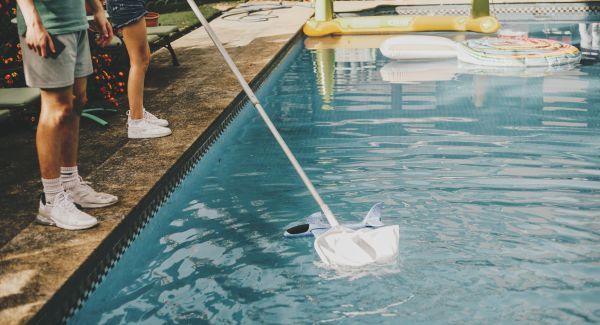
Last Updated on July 26, 2024
Nothing says summer more than a crystal-clear, sparkling pool. And nothing says “yikes” more than a stained pool full of murky water and floating debris.
We’re here with 12 tips to keep your pool from ever approaching “yikes” territory. Join us as we dive into pool maintenance tips that any homeowner can tackle with confidence!
Tip the scales in your favor
That sketchy white stain that makes itself known on the sides of the pool? It’s called calcium scaling, and it’s a sign that the pool’s calcium and pH levels are out of whack. Prevention is your best friend when it comes to scaling, so be sure to test water chemistry regularly (more on this in Tip #3)
If you’re already dealing with scaling, the first step in tackling the problem is figuring out whether the culprit is calcium carbonate or calcium silicate. Place a few drops of muriatic acid on a deposit (be sure to follow safety precautions any time you’re working with acids). Calcium carbonate will react to the acid by foaming, while calcium silicate will have no reaction.
To treat calcium carbonate stains on concrete pools, loosen the deposit first using a calcium descaling spray, and then scrub the scale away using a pumice stone. Keep the area wet the entire time you’re scrubbing to avoid scratches. To remove calcium carbonate deposits on a vinyl pool, use a descaler removal gel.
If the scale is calcium silicate and you have a concrete or tile pool, use a healthy dose of elbow grease and a pumice stone to scrub it away. If your vinyl pool has noticeable calcium silicate deposits, professional treatment is required.
Once you have gotten rid of visible deposits, test your water to make sure the treatment did not alter the chemical balance, and regularly test to prevent future calcium scaling.
Vacuum regularly
What do pools and living rooms have in common? They’re both ideal places to have a party, and they both need to be vacuumed regularly.
Vacuum your pool once a week, using the same strategy you use for your living room: work off a straight line grid, overlapping your previous path slightly to make sure you’re covering the entire area.
And just like in our living rooms, people who invest in robot vacuums swear by them!
Put your water to the test
It’s crucial to test the chemical levels in your pool water regularly, because improper levels can cause murky water, skin and eye irritation, and bacteria growth. The good news is that you don’t have to be a chemist to stay on top of it. You just need to keep good testing kits in stock and do a test at least once a week during peak season, and every one to two months during the off-season.
The three main levels you’re looking at are pH, alkalinity, and sanitizer. A pool with properly balanced levels is clear, odor free, and leaves barley any residue on skin. Consult your pool professional on the best schedule for shocking your pool.
Pump, pump it up
Circulating your pool water is an essential part of pool maintenance and will help you avoid headache-inducing issues in the future. Experts recommend running the pump at least eight to 12 hours per day, and it’s fine to split up running time into various chunks throughout the day. Investing in a pump timer helps simplify this important step in pool maintenance.
Take your vitamins
Vitamin C, specifically…it turns out that vitamin C tablets can remove unsightly stains in your pool caused by metals in the water. For small stains, rubbing a vitamin C tablet back and forth across the area can do the job.
Larger stains can be treated by sprinkling ascorbic acid evenly over the surface of the water (half a pound per 10,000 gallons of pool water). Turn your filter to circulate for 30 minutes, repeating this process until the stain is gone.
Bonus tip: To avoid metal stains in the first place, test your water source, for instance your hose, for metals. If metals are coming from your water source, add a filter to the source so the metals don’t end up in your pool. Experts also recommend checking your pool plumbing for rust, and maintaining pH levels in your pool water, as low pH levels cause corrosive acidic water.
Scratch the surface
Skimming the surface of your pool every day will catch floating debris before it ends up on the bottom of the pool where it could hang out and make your water funky (not to mention being harder to find and clean up). Regular skimming also increases the efficiency of your pool’s circulation system, which saves you money in the long run.
Bonus tip: to make your net even more powerful, cover it with an old pair of pantyhose. This fabric will trap fine debris and dirt that would otherwise get through the net.
Oil and water don’t mix
This is probably our favorite tip because it could not be easier or cheaper. Drop an old tennis ball into your pool, and the wool and vinyl fibers of the ball will absorb oil from suntan lotion, hair products, and skin. Keeping this oil from accumulating will help achieve that summer sparkle we associate with clean swimming pools. Simply replace the tennis ball when it starts to show wear and tear.
Save on scrubbing
Brushing the surfaces of your pool regularly is a must, as it helps minimize calcium deposits and algae growth. Make sure you get a professional recommendation on the best brush to use for the particular surfaces in your pool.
Don’t forget about the corners, ladder fittings, and lights. While there are plenty of expensive solutions and substances on the market for pool cleaning, you can save money by using a paste of baking soda and water.
Another level to check
We’ve covered how important it is to check the chemical levels regularly. It’s also important to monitor the actual water level. Rain, evaporation, and heavy use can all affect the water level. Having too much or too little water can seriously damage your skimmer.
What’s the perfect level? You want the water line to be at the halfway point of your skimmer hatch. You’re more likely to have to add water than you are to remove it, which is great news because adding is much easier than removing!
Use a garden hose to add water until it reaches the proper level. To remove water, you will most likely need to get help, including the right equipment, from a professional. Make sure you test chemical levels once you’ve achieved the right water level.
Keep the filter happy
New pool owners may be surprised to learn that there is such a thing as a too-clean filter. It’s actually beneficial for your filter to contain a mild amount of dirt, as that helps trap other particles and debris.
The proper methods and tools for cleaning the filter depend on the type of filter in your pool, so get clear instructions from your manufacturer or your pool professional, and follow them closely. Signs that it’s time to clean your filter include a clogged drain and abnormal odors.
Shock your pool
Shocking the pool involves adding a high dose of chlorine to eliminate bacteria and organic contaminants. You can do this about every 1-2 weeks, especially after heavy use or a storm, to keep the water clean and clear. You know you need to shock your pool if you see algae growing or if the free chlorine level of your pool measures zero. Always follow the manufacturer’s instructions for the correct dosage!
Expert Tip: Shock your pool at dusk because the sun will burn off unstabilized chlorine!
Check for leaks
Regularly inspect your pool for any signs of leaks, such as unexplained water loss, wet spots around the pool, or cracks in the pool structure. Detecting these leaks and repairing them early will prevent more significant issues, saving you money in the long run.



